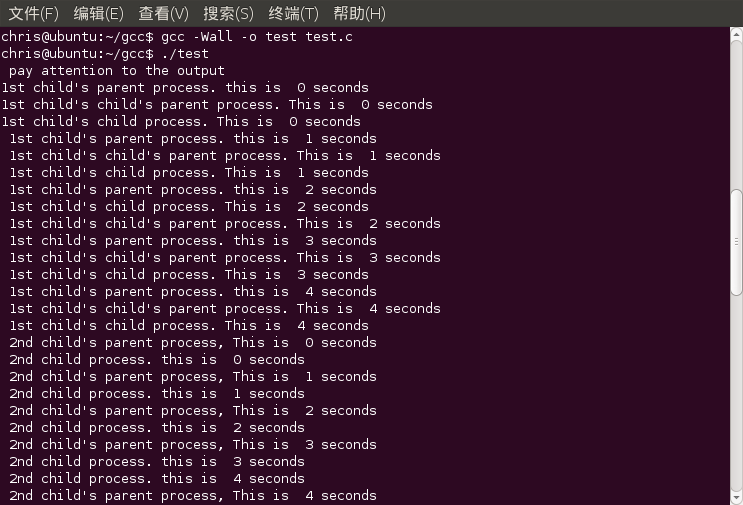EG1 : system函数:
NAME
system - execute a shell command
SYNOPSIS
#include <stdlib.h>
int system(const char *command);
DESCRIPTION
system() executes a command specified in command by calling /bin/sh -c
command, and returns after the command has been completed. During exe‐
cution of the command, SIGCHLD will be blocked, and SIGINT and SIGQUIT
will be ignored.#include<stdio.h>
#include<stdlib.h>
#include<sys/types.h>
#include<unistd.h>
#include<sys/wait.h>
int main(int argc , char **agrv){
pid_t pid ;
int state ;
pid = fork() ;
if(pid < 0){
printf("Erorr!\n");
return -1 ;
}
if(pid == 0){
//子进程
system("gvim new_file");
exit(0) ;
}
else{
//父进程
if( waitpid(pid, &state , 0) !=pid ) state = -1 ;
//父进程等待子进程执行完之后再继续执行,waitpid函数成功是返回state值改变的在子进程的ID ,错误返回-1
printf("The state is : %d\n",state);
}
return 0;
}以下写的这个my_system函数的功能和上面的system是类似的,不过就是自己写的而已:
#include<stdio.h>
#include<sys/types.h>
#include<unistd.h>
#include<stdlib.h>
#include<sys/wait.h>
#define SHELL "/bin/sh"
int my_system(const char *command){
int state ;
pid_t pid ;
pid = fork() ;
if(pid == 0){
//子进程
execl(SHELL,SHELL,"-c",command ,NULL);
exit(EXIT_FAILURE);
}
else if(pid > 0){
//父进程
if( waitpid(pid , &state , 0) != pid) state = -1 ;
}
else state = -1 ;
return state ;
}
int main(){
printf("This is the return value : %d\n",my_system("gvim creat_new_file"));
return 0;
}EG2 :多进程和sleep函数
/*
Linux进程学习,多进程和sleep函数。
2011-12-24
Ivan_zjj
*/
#include<stdio.h>
#include<unistd.h>
#include<stdlib.h>
#include<sys/types.h>
int main(){
int status = 0;
pid_t child_1_pid,child_2_pid;
child_1_pid = fork(); /* 这是第一个子进程 */
if (child_1_pid == 0){
/* 这是第一个子进程的代码 */
pid_t child_child_pid;
child_child_pid = fork(); /* 这是第一个子进程的子进程 */
if( child_child_pid == 0){
/* 这是第一个子进程的子进程的代码 */
int child_child_i;
for ( child_child_i = 0; child_child_i < 5; child_child_i++){
printf("1st child's child process. This is %2d seconds\n ", child_child_i);
sleep(1); /* 注意:修改等待时间,会得到什么结果呢? */
}
_exit(0);
}
else if( child_child_pid > 0 ){
/* 这是第一个子进程的子进程的第一个子进程的代码 */
int child_1_i;
for( child_1_i = 0; child_1_i < 5; child_1_i++){
printf("1st child's child's parent process. This is %2d seconds\n ", child_1_i);
sleep(1);
}
_exit(0);
}
else{
/* 创建第一个子进程的子进程失败了 */
status = -1;
_exit(0);
}
}
else if( child_1_pid > 0 ){
/* 这是第一个子进程的父进程(即最高的那个父进程) */
int child_1_parent_i;
for( child_1_parent_i = 0; child_1_parent_i < 5; child_1_parent_i++){
printf("1st child's parent process. this is %2d seconds\n ", child_1_parent_i);
sleep(1);
}
//_exit(0); /* 要是不将这行注释掉, 下面的第二个进程就不能创建了。因为父进程运行到这里就返回了。*/
}
else{
/* 创建第一个子进程失败 */
printf(" fork 1st child process failed\n ");
status = -1;
_exit(1);
}
/* 创建第一级的第二个子进程 */
child_2_pid = fork();
if( child_2_pid == 0){
/* 这是第一级的第二个的子进程的代码 */
int child_2_i;
for( child_2_i = 0; child_2_i < 5; child_2_i++)
{
printf("2nd child process. this is %2d seconds\n ",child_2_i);
sleep(1);
}
_exit(0);
}
else if( child_2_pid > 0)
{
/* 这是第一级的第二个子进程的父进程(最高级进程)的代码 */
int child_2_parent_i;
for( child_2_parent_i = 0; child_2_parent_i < 5; child_2_parent_i++)
{
printf("2nd child's parent process, This is %2d seconds\n ",child_2_parent_i);
sleep(1);
}
_exit(0);
}
else
{
/* 创建第一级第二个子进程失败 */
printf(" fork 2nd child process failed\n");
status = -1;
_exit(1);
}
return status;
}
运行结果:






















 1149
1149











 被折叠的 条评论
为什么被折叠?
被折叠的 条评论
为什么被折叠?








